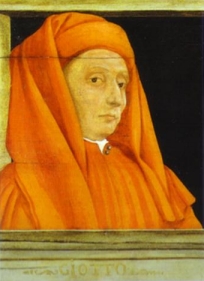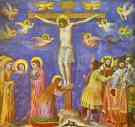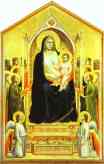Giotto Biography

Giotto di Bondone is an Italian painter and architect, born in Vespignano, near Florence. The most innovative artist of his time, Giotto was described by Dante as the foremost painter, displacing the elder Cimabue in fame and fortune. Posterity, however, has seen Giotto in stronger terms, as the revolutionary who altered the course of painting in Western Europe, striking out of the Gothic and Byzantine styles towards the Renaissance.
At the age of 10, Giotto was supposedly found by Cimabue (1240-1302), who took him to Florence to study art. His earliest work may have been connected with the making of mosaics for the Florence Baptistry.
Giotto was a citizen of Florence, though he also worked in Assisi, Rome, Padua, Milan and Naples. His art and evident business shrewdness made him sufficiently prosperous: he married twice, supported eight children and provided handsome marriage settlements for 2 daughters. His workshop flourished: 3 paintings signed by him survived, but most of the art historians consider them to be the work of his assistants, signed by Giotto almost as a brand-name.
His most important works are: the frescos in the Capella degli Scrovegni, Padua; the Navicella mosaic in Saint Peter’s, Rome; the cycles of frescos depicting scenes from the life of Saint Francis, at Assisi; frescos in the Church of Santa Croce in Florence; and the Ognissanti Madonna (c.1305-1310), now in the Uffizi, Florence.
In 1334 Giotto was appointed master of works for the cathedral and city of Florence. Aided by Andrea Pisano (1270-1349, Italian sculptor), he decorated the façade of the cathedral with statues and designed the campanile himself. It still bears his name but is much altered.
For the last 2 years of life he worked in Milan and is believed to have died at the age of 70 in 1337. Many facts and episodes of his life were made up by later historians, so very little is actually known. For a time his name was a synonym for the word ‘painter’.
The impact of Giotto’s innovations can be seen in the work of Masaccio a century later and ultimately in the work of Michelangelo himself, who studied and made copies of Giotto’s compositions.
Bibliography
Giotto. by I. Danilova. Moscow. 1970.
The Art of the Italian Renaissance. Architecture. Sculpture. Painting. Drawing. Könemann. 1995.
Painting of Europe. XIII-XX centuries. Encyclopedic Dictionary. Moscow. Iskusstvo. 1999.
Giotto (Masters of Italian Art Series) by Anne Mueller, Von Der Haegen. Konemann, 1998.
Giotto: The Scrovegni Chapel, Padua (Great Fresco Cycles of the Renaissance) by Bruce Cole. George Braziller, 1993.
Giotto: The Arena Chapel Frescoes: Illustrations, Introductory Essay, Backgrounds and Sources, Criticism (Norton Critical Studies in Art History) by James H. Stubblebine (Editor). W.W. Norton & Company, 1996.
Giotto: Frescoes in the Scrovegni Chapel by Giuseppe Basile. Skira, 2003.
Giotto by Francesca Flores D'Arcais. Abbeville Press, 1995.
Painting in the Age of Giotto: A Historical Reevaluation by Hayden B. J. Maginnis. Pennsylvania State University Press, 1997.
- The Crucifixion.

1304-1306. Fresco. Capella degli Scrovegni, Padua, Italy. Read Note.
- Madonna And Child Enthroned With Saints (Ognissanti Madonna).

c.1305-1310. Tempera on panel. Galleria degli Uffizi, Florence, Italy.